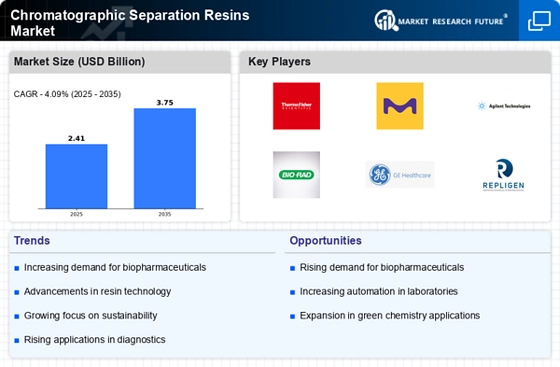Increased Focus on Quality Control
Quality control remains a pivotal concern within the Chromatographic Separation Resins Market. Regulatory bodies are imposing stringent guidelines to ensure the safety and efficacy of pharmaceutical products. Consequently, manufacturers are investing in high-quality chromatographic resins that can meet these regulatory standards. The market for quality control in pharmaceuticals is projected to grow significantly, with an emphasis on analytical techniques that utilize chromatographic separation. This focus on quality assurance is likely to drive innovation and demand within the Chromatographic Separation Resins Market, as companies strive to comply with evolving regulations.
Rising Demand in Biopharmaceuticals
The Chromatographic Separation Resins Market is experiencing a notable surge in demand driven by the biopharmaceutical sector. As the industry continues to expand, the need for efficient purification processes becomes paramount. Chromatographic separation resins play a critical role in the purification of monoclonal antibodies and other biologics. Recent estimates suggest that the biopharmaceutical market could reach USD 500 billion by 2025, thereby propelling the demand for advanced separation technologies. This trend indicates a robust growth trajectory for the Chromatographic Separation Resins Market, as companies seek to enhance yield and purity in their production processes.
Expansion of Analytical Testing Services
The expansion of analytical testing services is contributing to the growth of the Chromatographic Separation Resins Market. As industries such as food and beverage, environmental monitoring, and pharmaceuticals require rigorous testing, the demand for chromatographic techniques is increasing. Analytical laboratories are adopting advanced chromatographic methods to ensure compliance with safety standards and regulations. The market for analytical testing services is projected to grow significantly, with a focus on enhancing accuracy and reliability. This trend suggests a promising outlook for the Chromatographic Separation Resins Market, as it aligns with the growing need for precise analytical solutions.
Emergence of Advanced Separation Techniques
The Chromatographic Separation Resins Market is witnessing the emergence of advanced separation techniques that enhance efficiency and effectiveness. Innovations such as high-performance liquid chromatography (HPLC) and ultra-high-performance liquid chromatography (UHPLC) are gaining traction. These technologies enable faster and more precise separations, which are essential in various applications, including pharmaceuticals and environmental testing. The market for HPLC is expected to grow at a compound annual growth rate (CAGR) of approximately 6% over the next few years. This growth indicates a strong potential for the Chromatographic Separation Resins Market as it adapts to these technological advancements.
Growing Investment in Research and Development
Investment in research and development is a significant driver for the Chromatographic Separation Resins Market. As companies strive to innovate and improve their product offerings, R&D initiatives are becoming increasingly vital. This investment is particularly evident in the pharmaceutical and biotechnology sectors, where the development of new drugs necessitates advanced separation technologies. Reports indicate that R&D spending in the pharmaceutical industry could exceed USD 200 billion annually by 2025. Such financial commitment is likely to bolster the demand for chromatographic separation resins, as researchers seek to optimize their processes and achieve better results.

















Leave a Comment